
Alban Maria Johannes Berg was an Austrian composer of the Second Viennese School. His compositional style combined Romantic lyricism with twelve-tone technique.

Frederick III was Holy Roman Emperor from 1452 until his death. He was the first emperor of the House of Habsburg, and the fourth member of the House of Habsburg to be elected King of Germany after Rudolph I of Germany, Albert I in the 13th century and his predecessor Albert II of Germany. He was the penultimate emperor to be crowned by the Pope, and the last to be crowned in Rome.

Wilhelm II was the last German Emperor (Kaiser) and King of Prussia, reigning from 15 June 1888 until his abdication on 9 November 1918 shortly before Germany's defeat in World War I. He was the eldest grandchild of Queen Victoria of the United Kingdom and related to many monarchs and princes of Europe, most notably his first cousin King George V of the United Kingdom and Emperor Nicholas II of Russia, whose wife, Alexandra, was Wilhelm and George's first cousin.

Kaiser is the German word for "emperor". Like the Bulgarian, Serbian and Russian word Tsar, it is directly derived from the Roman emperors' title of Caesar, which in turn is derived from the personal name of a branch of the gens (clan) Julia, to which Gaius Julius Caesar, the forebear of the first imperial family, belonged. Although the British monarchs styled "Emperor of India" were also called Kaisar-i-Hind in Hindi and Urdu, this word, although ultimately sharing the same Latin origin, is derived from the Greek: Καῖσαρ (kaisar), not the German Kaiser.

Philipp Veit was a German Romantic painter. It is to Veit that the credit of having been the first to revive the nearly forgotten technique of fresco painting is due.

Karl Wilhelm FriedrichSchlegel, usually cited as Friedrich Schlegel, was a German poet, literary critic, philosopher, philologist and Indologist. With his older brother, August Wilhelm Schlegel, he was one of the main figures of the Jena romantics. He was a zealous promoter of the Romantic movement and inspired Samuel Taylor Coleridge, Adam Mickiewicz and Kazimierz Brodziński. The first to notice what became known as Grimm's law, Schlegel was a pioneer in Indo-European studies, comparative linguistics, and morphological typology. As a young man he was an atheist, a radical, and an individualist. In 1808, the same Schlegel converted to Catholicism. Two years later he was a diplomat and journalist in the service of the reactionary Clemens von Metternich, surrounded by monks and pious men of society.

Carl Friedrich Christian Mohs was a German geologist and mineralogist. He was the creator of the Mohs scale of mineral hardness. Mohs also introduced a classification of the crystal forms in crystal systems independently of Christian Samuel Weiss.

"Gott erhalte Franz den Kaiser" is a personal anthem to Francis II, Emperor of the Holy Roman Empire and later of the Austrian Empire. The lyrics were by Lorenz Leopold Haschka (1749–1827), and the melody by Joseph Haydn. It is sometimes called the "Kaiserhymne". Haydn's tune has since been widely employed in other contexts: in works of classical music, in Christian hymns, in alma maters, and as the tune of the "Deutschlandlied", the national anthem of Germany.

Archduke Albrecht Friedrich Rudolf Dominik of Austria, Duke of Teschen was an Austrian Habsburg general. He was the grandson of Emperor Leopold II and one of the chief military advisors of Emperor Francis Joseph I. As Inspector General for 36 years, he was an old-fashioned bureaucrat who largely controlled the Austro-Hungarian Army and delayed modernization. he was honored with the rank of Field Marshal in the armies of Austria-Hungary (1888) and Germany (1893).
Friedrich Waismann was an Austrian mathematician, physicist, and philosopher. He is best known for being a member of the Vienna Circle and one of the key theorists in logical positivism.

Friedrich Carl Georg Kaiser, called Georg Kaiser, was a German dramatist.
The von Hurter family belonged to the Swiss nobility; in the eighteenth and nineteenth centuries three of them were known for their conversions to Roman Catholicism, their ecclesiastical careers in Austria and their theological writings.

Johann Friedrich Reichardt was a German composer, writer and music critic.

Carl Gangolf Kayser was an Austrian architect at the service of Emperor Maximilian I of Mexico, during the Second Mexican Empire. In the later part of his life he returned to Austria and worked on restoring medieval castles.
Karl Anton Hickel was an 18th-century painter.

Viktor Oskar Tilgner, Hungarian: Tilgner Viktor, Tilgner Viktor Oszkár was an Austrian sculptor and medailleur.
Eduard Kaiser was an Austrian painter and lithographer, as was his brother Alexander Kaiser (1819–1872).

The Supreme Commander of the Imperial and Royal Armed Forces was the ultimate authority of the Austro-Hungarian Armed Forces – which comprised the Army, Navy and Aviation Troops of Austria-Hungary.

Friedrich Paul Theodor Sarre was a German Orientalist, archaeologist and art historian. During his lifetime, he amassed an impressive collection of Islamic art.
Bernd Kaiser is a German coxswain. He was the cox of the East German eight that became world champion in 1978.

















